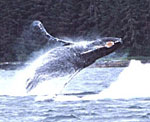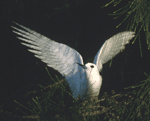|
|
|
|
||||||||||||||||
Home
sweet homing: the tricks of animal navigation
Imagine you're exploring a cave with a group of people: the leader, in front, is the only one with a light. She's up ahead, forging her way forward, the light of her lamp lost around a distant corner. Around you, the world is pitch black, but through the darkness you hear calls of "over here!" and "follow me this way!" The people in your group can navigate their way through the dark by using sound to tell each other where they are and where they're headed. Whales signal each other the same way as they move through the thousands of miles of their migration path along the Pacific coast. Using their whale songs as sonar , they can discern the location of nearby members of their group, or pod. Some whale researchers and activists worry that the Navy's use of low-frequency active (LFA) sonar could interfere with whales' migration abilities, separating some whales from the pod or causing others to strand on the shore. There is already evidence to suggest that sonar, and ocean noise pollution in general, is threatening many species of sea life. The Navy argues that for the most part, its short-term tests have shown that whales usually return to their normal navigation after the sonar sounds stop. And government officials have stressed the importance of underwater surveillance in the wake of the Septermber 11th attacks. For more on this debate, listen to Rebecca Roberts's story.
Animal magnetism Each year, whales migrate from Hawaii to the northern Pacific coast, and back. How do they manage to find the tiny islands in that vast sea? Sonar may help them stay together and follow one another, but they must use some other means to remember and relocate their destination. Many researchers believe whales use biomagnetism to do this. We already know about lots of animals and birds that use magnetic material in their bodies to help them understand where they are. For example, the Arctic tern makes a pilgrimmage from the North Pole to the South Pole and back every year. The tern has a compound called biomagnetite in its brain, that may make its brain cells sensitive to changes in the earth's magentic field. As the tern flies, it may be able to sense the direction of the surrounding magnetic field and use that information to guide it. B iomagnetite has been found in the brains of whales and dolphins, and it is widely believed that marine mammals use magnetism as well as sonar to direct themselves during migration.
Sensing the route More than any other sense, humans use their vision to navigate. We often look for landmarks, and use them to tell us what direction we've come from and to help us locate a path or nearby places. In other words, we use what we see in combination with what we remember to help us find our way home. Some researchers believe whales and other animals do the same sort of thing. The water whales migrate in is often too dark for them to actually see features on the ocean floor. But just as sonar helps them find food nearby, whales can also use their sounds to "see" what's around them. They may remember a path defined by some landmarks below them, and this may help them find their way along the coast from Hawaii to Alaska. Other animals who travel in brighter environments use their vision to navigate. The arctic tern mentioned earlier also uses landmarks like the African and European coastlines to help navigate its long flight from pole to pole. During the night, stars and the moon can guide the birds. Some insects, like locusts, also use the sun to migrate. Even the sense of smell can lead animals home: scientists believe the salmon's famous swim upstream to its birthplace is guided by a signature smell of the fish's stream.
|
|
|||||||||||||||||
|
© Exploratorium |
||||||||||||||||||


